Statistical Report: Factors Influencing Employee Performance in Retail
VerifiedAdded on 2021/04/24
|31
|4401
|59
Report
AI Summary
This report presents a statistical analysis of employee performance within a fictitious retail company, utilizing a dataset of 40 employees. The analysis explores the relationships between various factors, including IQ level, age, sleeping habits, completed assignments, and average monthly ratings, to determine their impact on employee performance and the receipt of Reward and Recognition (R&R). The study employs a range of statistical techniques, such as linear regression, single and independent t-tests, cross-tabulations, chi-square tests, and one-way ANOVA, to draw inferences and conclusions. The results, derived with the aid of SPSS-20, reveal significant correlations between certain factors and employee outcomes, highlighting the importance of factors like IQ, and R&R on employee performance. The report also investigates the influence of habits like smoking and drinking, the difficulty level of tasks, and gender on employee performance metrics. The findings are presented in detail, complete with descriptive statistics, graphical representations, and interpretations, offering valuable insights into employee behavior and its impact on the workplace. The report concludes with a discussion of the implications of these findings and recommendations for improving employee performance and fostering a positive work environment.
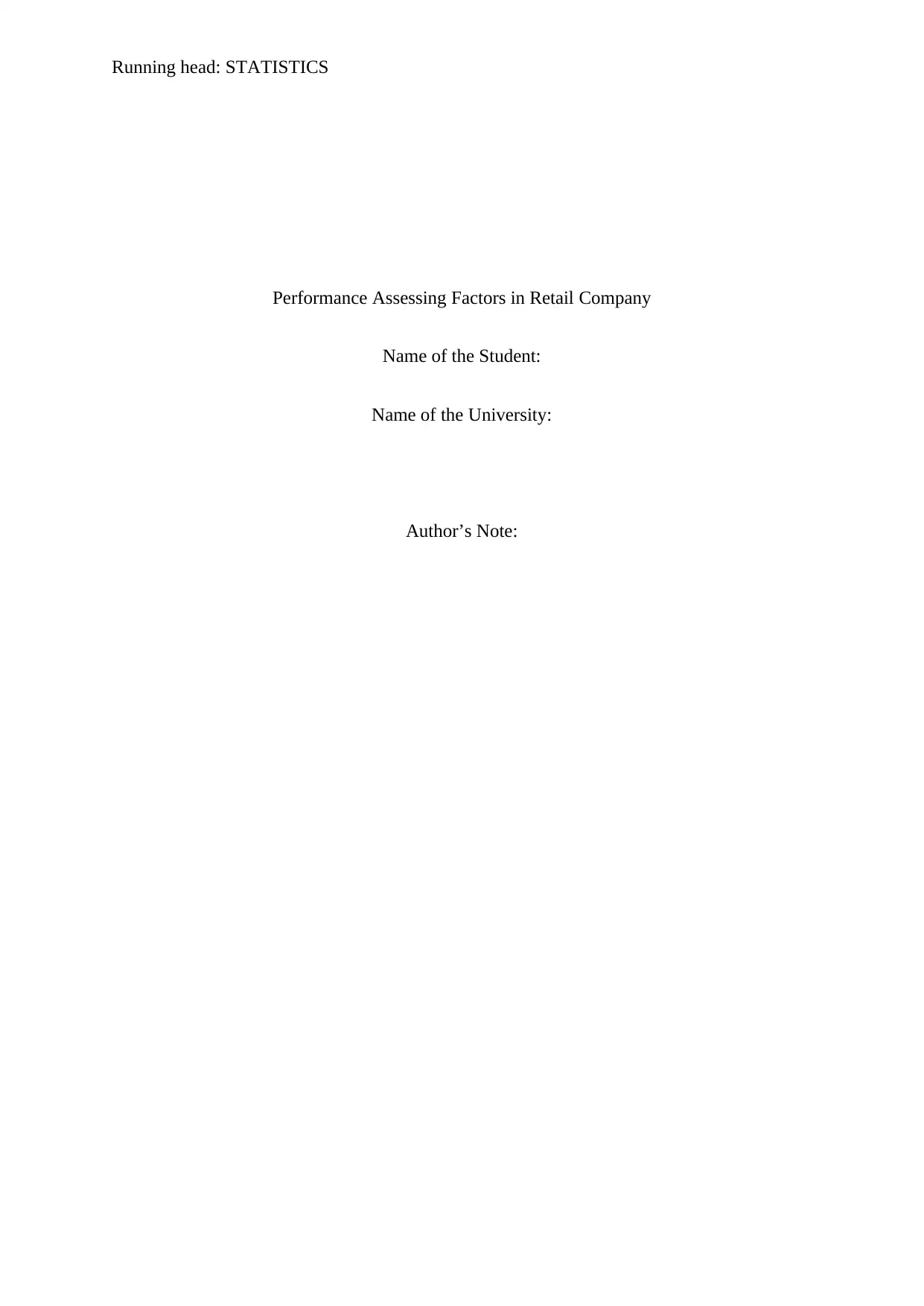
Running head: STATISTICS
Performance Assessing Factors in Retail Company
Name of the Student:
Name of the University:
Author’s Note:
Performance Assessing Factors in Retail Company
Name of the Student:
Name of the University:
Author’s Note:
Paraphrase This Document
Need a fresh take? Get an instant paraphrase of this document with our AI Paraphraser
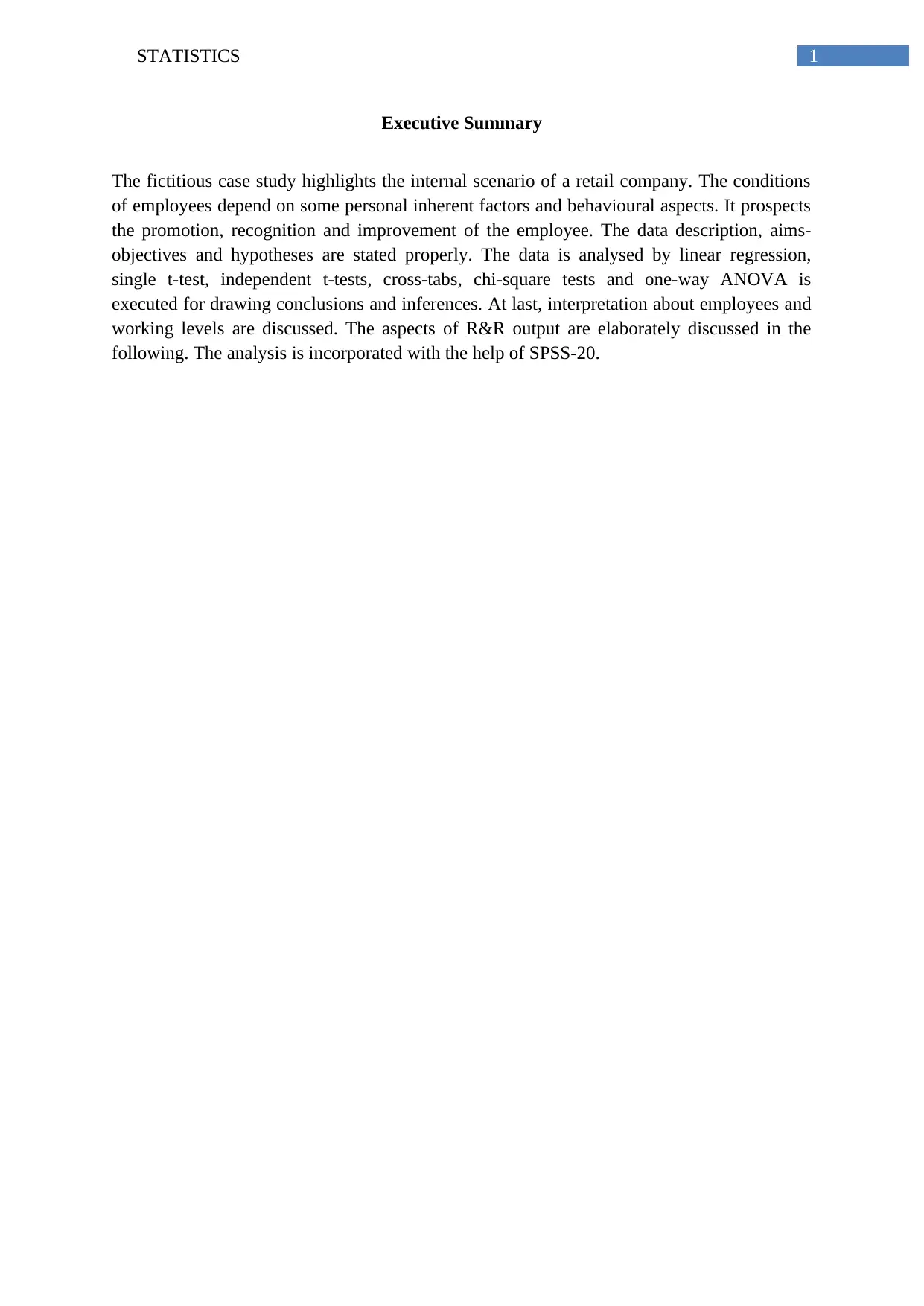
1STATISTICS
Executive Summary
The fictitious case study highlights the internal scenario of a retail company. The conditions
of employees depend on some personal inherent factors and behavioural aspects. It prospects
the promotion, recognition and improvement of the employee. The data description, aims-
objectives and hypotheses are stated properly. The data is analysed by linear regression,
single t-test, independent t-tests, cross-tabs, chi-square tests and one-way ANOVA is
executed for drawing conclusions and inferences. At last, interpretation about employees and
working levels are discussed. The aspects of R&R output are elaborately discussed in the
following. The analysis is incorporated with the help of SPSS-20.
Executive Summary
The fictitious case study highlights the internal scenario of a retail company. The conditions
of employees depend on some personal inherent factors and behavioural aspects. It prospects
the promotion, recognition and improvement of the employee. The data description, aims-
objectives and hypotheses are stated properly. The data is analysed by linear regression,
single t-test, independent t-tests, cross-tabs, chi-square tests and one-way ANOVA is
executed for drawing conclusions and inferences. At last, interpretation about employees and
working levels are discussed. The aspects of R&R output are elaborately discussed in the
following. The analysis is incorporated with the help of SPSS-20.
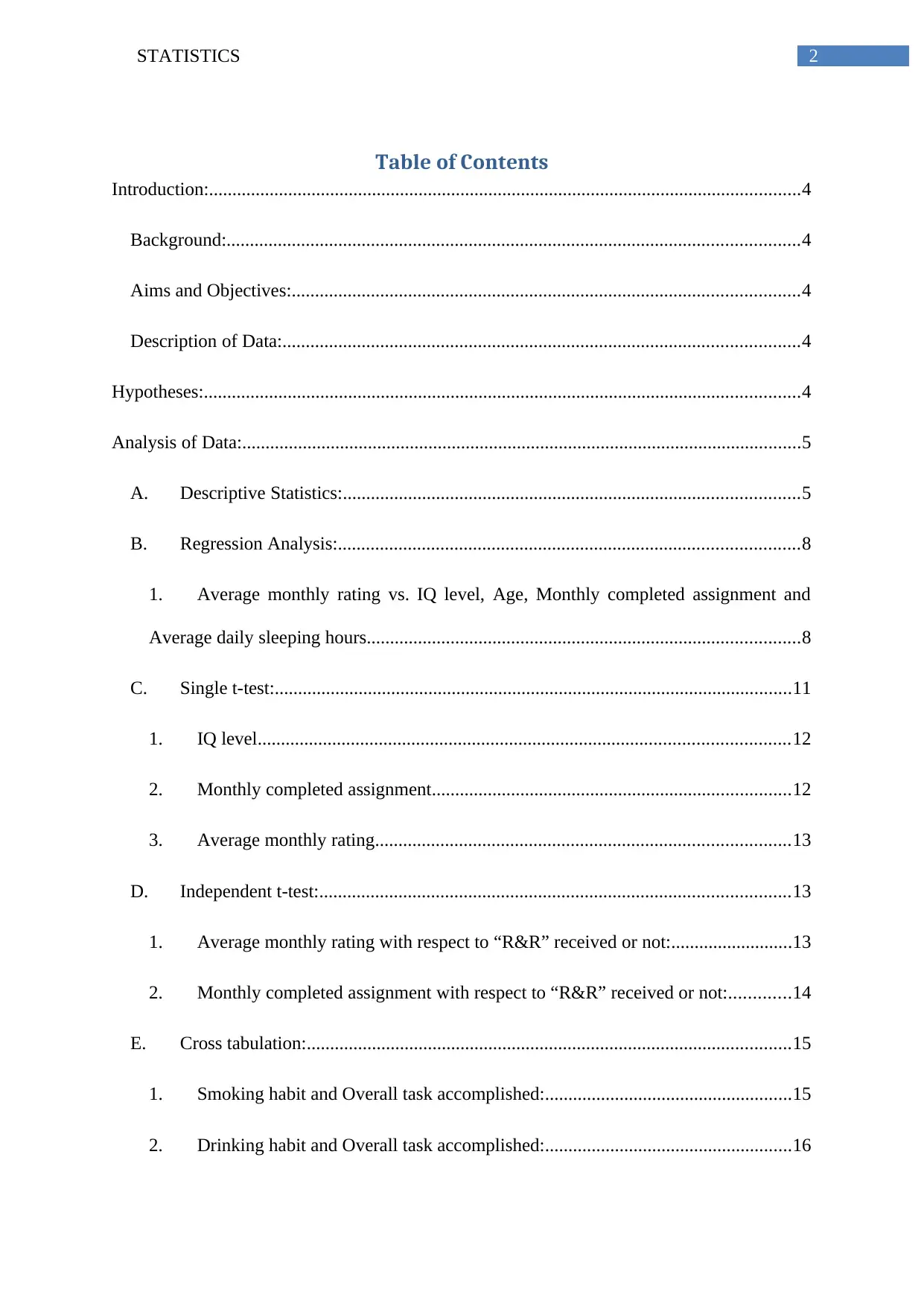
2STATISTICS
Table of Contents
Introduction:...............................................................................................................................4
Background:...........................................................................................................................4
Aims and Objectives:.............................................................................................................4
Description of Data:...............................................................................................................4
Hypotheses:................................................................................................................................4
Analysis of Data:........................................................................................................................5
A. Descriptive Statistics:..................................................................................................5
B. Regression Analysis:...................................................................................................8
1. Average monthly rating vs. IQ level, Age, Monthly completed assignment and
Average daily sleeping hours.............................................................................................8
C. Single t-test:...............................................................................................................11
1. IQ level..................................................................................................................12
2. Monthly completed assignment.............................................................................12
3. Average monthly rating.........................................................................................13
D. Independent t-test:.....................................................................................................13
1. Average monthly rating with respect to “R&R” received or not:..........................13
2. Monthly completed assignment with respect to “R&R” received or not:.............14
E. Cross tabulation:........................................................................................................15
1. Smoking habit and Overall task accomplished:.....................................................15
2. Drinking habit and Overall task accomplished:.....................................................16
Table of Contents
Introduction:...............................................................................................................................4
Background:...........................................................................................................................4
Aims and Objectives:.............................................................................................................4
Description of Data:...............................................................................................................4
Hypotheses:................................................................................................................................4
Analysis of Data:........................................................................................................................5
A. Descriptive Statistics:..................................................................................................5
B. Regression Analysis:...................................................................................................8
1. Average monthly rating vs. IQ level, Age, Monthly completed assignment and
Average daily sleeping hours.............................................................................................8
C. Single t-test:...............................................................................................................11
1. IQ level..................................................................................................................12
2. Monthly completed assignment.............................................................................12
3. Average monthly rating.........................................................................................13
D. Independent t-test:.....................................................................................................13
1. Average monthly rating with respect to “R&R” received or not:..........................13
2. Monthly completed assignment with respect to “R&R” received or not:.............14
E. Cross tabulation:........................................................................................................15
1. Smoking habit and Overall task accomplished:.....................................................15
2. Drinking habit and Overall task accomplished:.....................................................16
⊘ This is a preview!⊘
Do you want full access?
Subscribe today to unlock all pages.

Trusted by 1+ million students worldwide
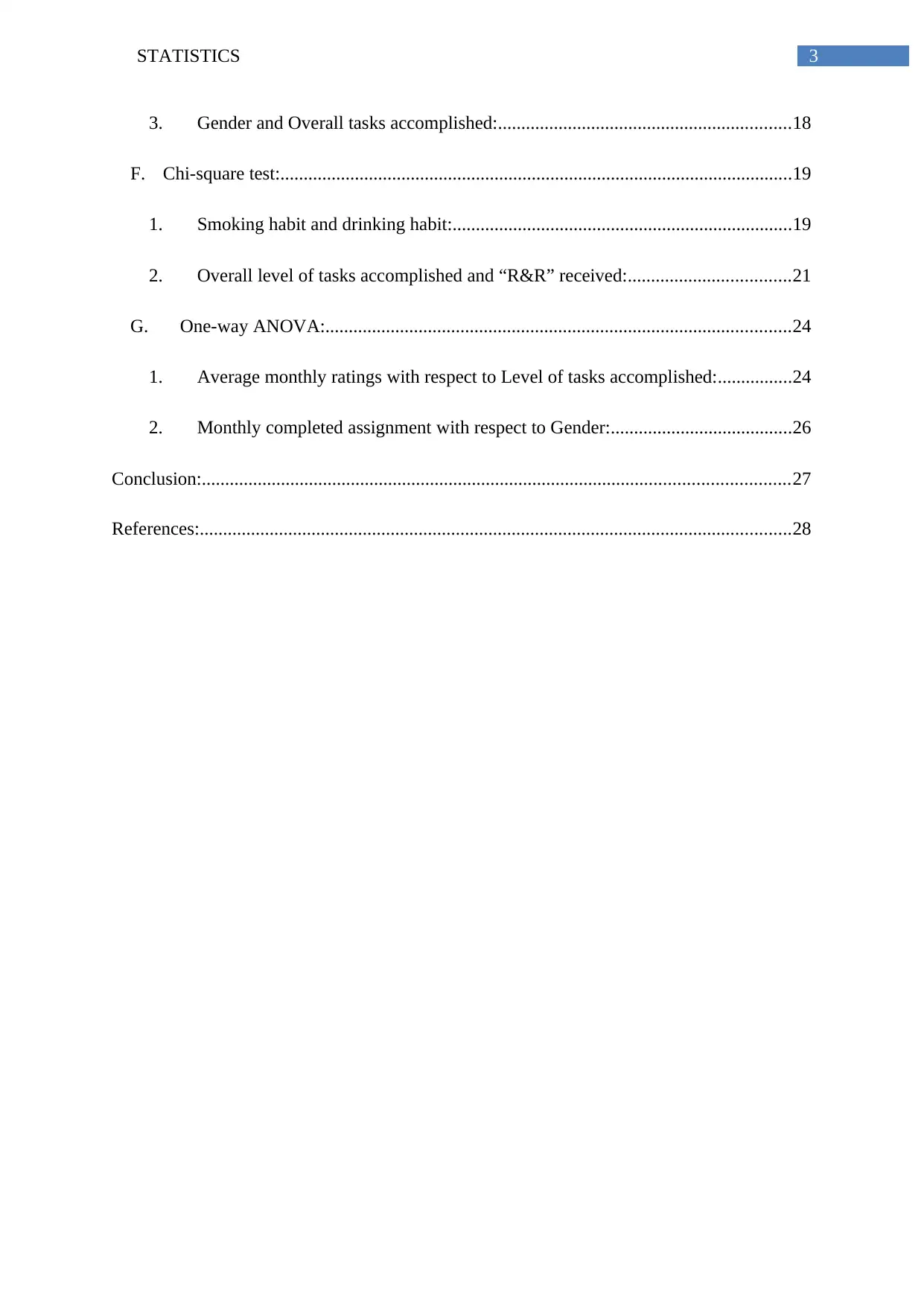
3STATISTICS
3. Gender and Overall tasks accomplished:...............................................................18
F. Chi-square test:..............................................................................................................19
1. Smoking habit and drinking habit:.........................................................................19
2. Overall level of tasks accomplished and “R&R” received:...................................21
G. One-way ANOVA:....................................................................................................24
1. Average monthly ratings with respect to Level of tasks accomplished:................24
2. Monthly completed assignment with respect to Gender:.......................................26
Conclusion:..............................................................................................................................27
References:...............................................................................................................................28
3. Gender and Overall tasks accomplished:...............................................................18
F. Chi-square test:..............................................................................................................19
1. Smoking habit and drinking habit:.........................................................................19
2. Overall level of tasks accomplished and “R&R” received:...................................21
G. One-way ANOVA:....................................................................................................24
1. Average monthly ratings with respect to Level of tasks accomplished:................24
2. Monthly completed assignment with respect to Gender:.......................................26
Conclusion:..............................................................................................................................27
References:...............................................................................................................................28
Paraphrase This Document
Need a fresh take? Get an instant paraphrase of this document with our AI Paraphraser
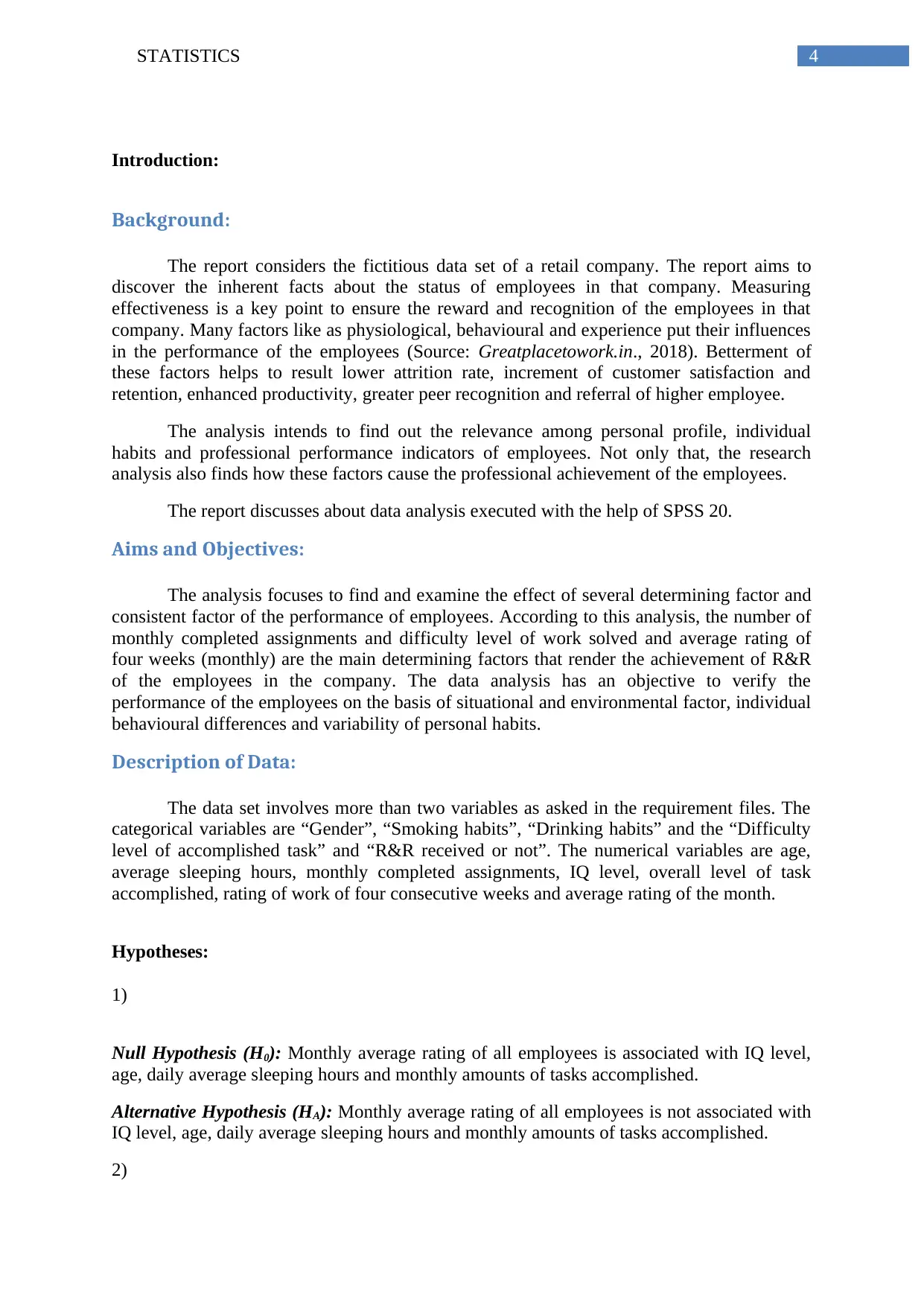
4STATISTICS
Introduction:
Background:
The report considers the fictitious data set of a retail company. The report aims to
discover the inherent facts about the status of employees in that company. Measuring
effectiveness is a key point to ensure the reward and recognition of the employees in that
company. Many factors like as physiological, behavioural and experience put their influences
in the performance of the employees (Source: Greatplacetowork.in., 2018). Betterment of
these factors helps to result lower attrition rate, increment of customer satisfaction and
retention, enhanced productivity, greater peer recognition and referral of higher employee.
The analysis intends to find out the relevance among personal profile, individual
habits and professional performance indicators of employees. Not only that, the research
analysis also finds how these factors cause the professional achievement of the employees.
The report discusses about data analysis executed with the help of SPSS 20.
Aims and Objectives:
The analysis focuses to find and examine the effect of several determining factor and
consistent factor of the performance of employees. According to this analysis, the number of
monthly completed assignments and difficulty level of work solved and average rating of
four weeks (monthly) are the main determining factors that render the achievement of R&R
of the employees in the company. The data analysis has an objective to verify the
performance of the employees on the basis of situational and environmental factor, individual
behavioural differences and variability of personal habits.
Description of Data:
The data set involves more than two variables as asked in the requirement files. The
categorical variables are “Gender”, “Smoking habits”, “Drinking habits” and the “Difficulty
level of accomplished task” and “R&R received or not”. The numerical variables are age,
average sleeping hours, monthly completed assignments, IQ level, overall level of task
accomplished, rating of work of four consecutive weeks and average rating of the month.
Hypotheses:
1)
Null Hypothesis (H0): Monthly average rating of all employees is associated with IQ level,
age, daily average sleeping hours and monthly amounts of tasks accomplished.
Alternative Hypothesis (HA): Monthly average rating of all employees is not associated with
IQ level, age, daily average sleeping hours and monthly amounts of tasks accomplished.
2)
Introduction:
Background:
The report considers the fictitious data set of a retail company. The report aims to
discover the inherent facts about the status of employees in that company. Measuring
effectiveness is a key point to ensure the reward and recognition of the employees in that
company. Many factors like as physiological, behavioural and experience put their influences
in the performance of the employees (Source: Greatplacetowork.in., 2018). Betterment of
these factors helps to result lower attrition rate, increment of customer satisfaction and
retention, enhanced productivity, greater peer recognition and referral of higher employee.
The analysis intends to find out the relevance among personal profile, individual
habits and professional performance indicators of employees. Not only that, the research
analysis also finds how these factors cause the professional achievement of the employees.
The report discusses about data analysis executed with the help of SPSS 20.
Aims and Objectives:
The analysis focuses to find and examine the effect of several determining factor and
consistent factor of the performance of employees. According to this analysis, the number of
monthly completed assignments and difficulty level of work solved and average rating of
four weeks (monthly) are the main determining factors that render the achievement of R&R
of the employees in the company. The data analysis has an objective to verify the
performance of the employees on the basis of situational and environmental factor, individual
behavioural differences and variability of personal habits.
Description of Data:
The data set involves more than two variables as asked in the requirement files. The
categorical variables are “Gender”, “Smoking habits”, “Drinking habits” and the “Difficulty
level of accomplished task” and “R&R received or not”. The numerical variables are age,
average sleeping hours, monthly completed assignments, IQ level, overall level of task
accomplished, rating of work of four consecutive weeks and average rating of the month.
Hypotheses:
1)
Null Hypothesis (H0): Monthly average rating of all employees is associated with IQ level,
age, daily average sleeping hours and monthly amounts of tasks accomplished.
Alternative Hypothesis (HA): Monthly average rating of all employees is not associated with
IQ level, age, daily average sleeping hours and monthly amounts of tasks accomplished.
2)
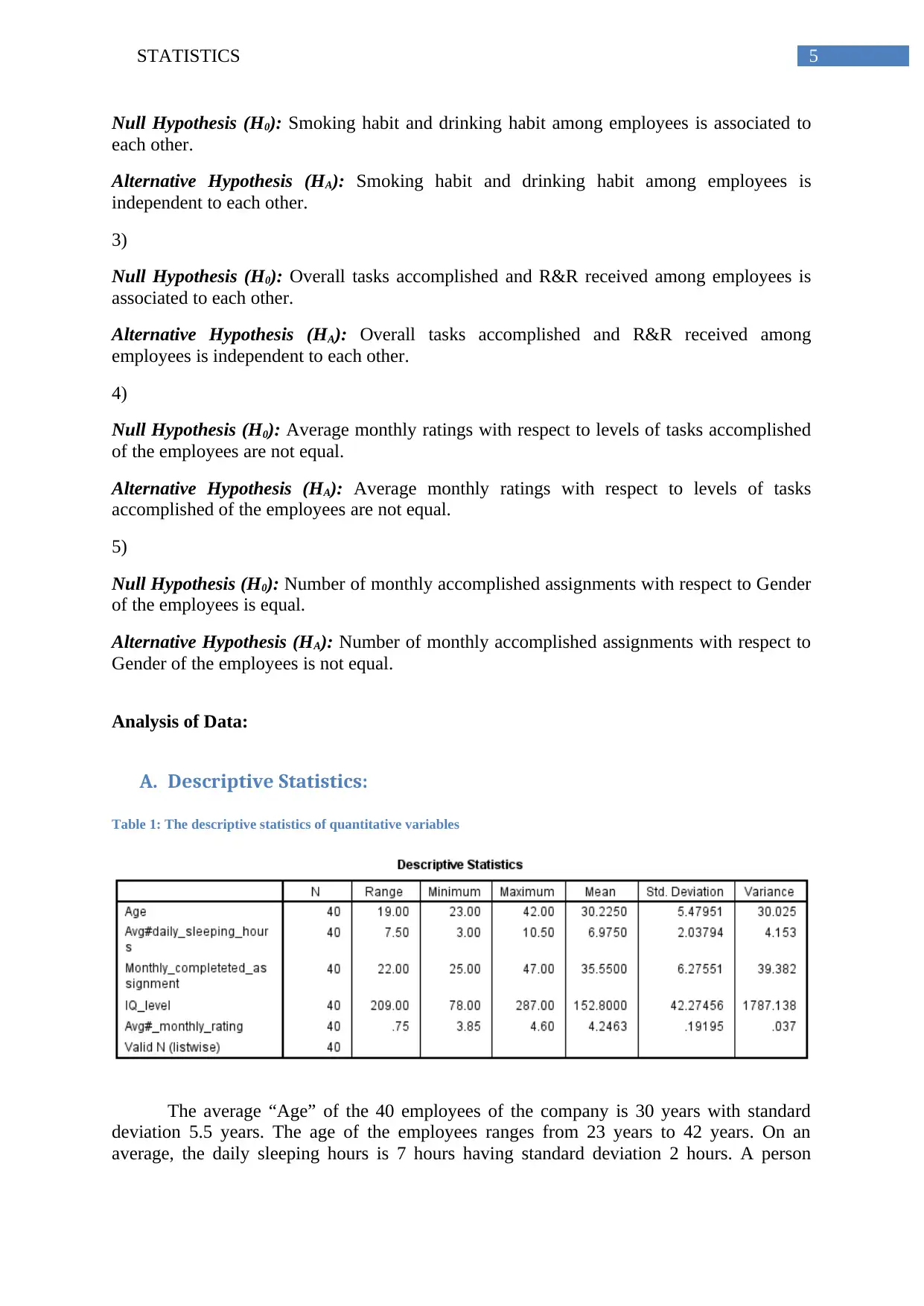
5STATISTICS
Null Hypothesis (H0): Smoking habit and drinking habit among employees is associated to
each other.
Alternative Hypothesis (HA): Smoking habit and drinking habit among employees is
independent to each other.
3)
Null Hypothesis (H0): Overall tasks accomplished and R&R received among employees is
associated to each other.
Alternative Hypothesis (HA): Overall tasks accomplished and R&R received among
employees is independent to each other.
4)
Null Hypothesis (H0): Average monthly ratings with respect to levels of tasks accomplished
of the employees are not equal.
Alternative Hypothesis (HA): Average monthly ratings with respect to levels of tasks
accomplished of the employees are not equal.
5)
Null Hypothesis (H0): Number of monthly accomplished assignments with respect to Gender
of the employees is equal.
Alternative Hypothesis (HA): Number of monthly accomplished assignments with respect to
Gender of the employees is not equal.
Analysis of Data:
A. Descriptive Statistics:
Table 1: The descriptive statistics of quantitative variables
The average “Age” of the 40 employees of the company is 30 years with standard
deviation 5.5 years. The age of the employees ranges from 23 years to 42 years. On an
average, the daily sleeping hours is 7 hours having standard deviation 2 hours. A person
Null Hypothesis (H0): Smoking habit and drinking habit among employees is associated to
each other.
Alternative Hypothesis (HA): Smoking habit and drinking habit among employees is
independent to each other.
3)
Null Hypothesis (H0): Overall tasks accomplished and R&R received among employees is
associated to each other.
Alternative Hypothesis (HA): Overall tasks accomplished and R&R received among
employees is independent to each other.
4)
Null Hypothesis (H0): Average monthly ratings with respect to levels of tasks accomplished
of the employees are not equal.
Alternative Hypothesis (HA): Average monthly ratings with respect to levels of tasks
accomplished of the employees are not equal.
5)
Null Hypothesis (H0): Number of monthly accomplished assignments with respect to Gender
of the employees is equal.
Alternative Hypothesis (HA): Number of monthly accomplished assignments with respect to
Gender of the employees is not equal.
Analysis of Data:
A. Descriptive Statistics:
Table 1: The descriptive statistics of quantitative variables
The average “Age” of the 40 employees of the company is 30 years with standard
deviation 5.5 years. The age of the employees ranges from 23 years to 42 years. On an
average, the daily sleeping hours is 7 hours having standard deviation 2 hours. A person
⊘ This is a preview!⊘
Do you want full access?
Subscribe today to unlock all pages.

Trusted by 1+ million students worldwide
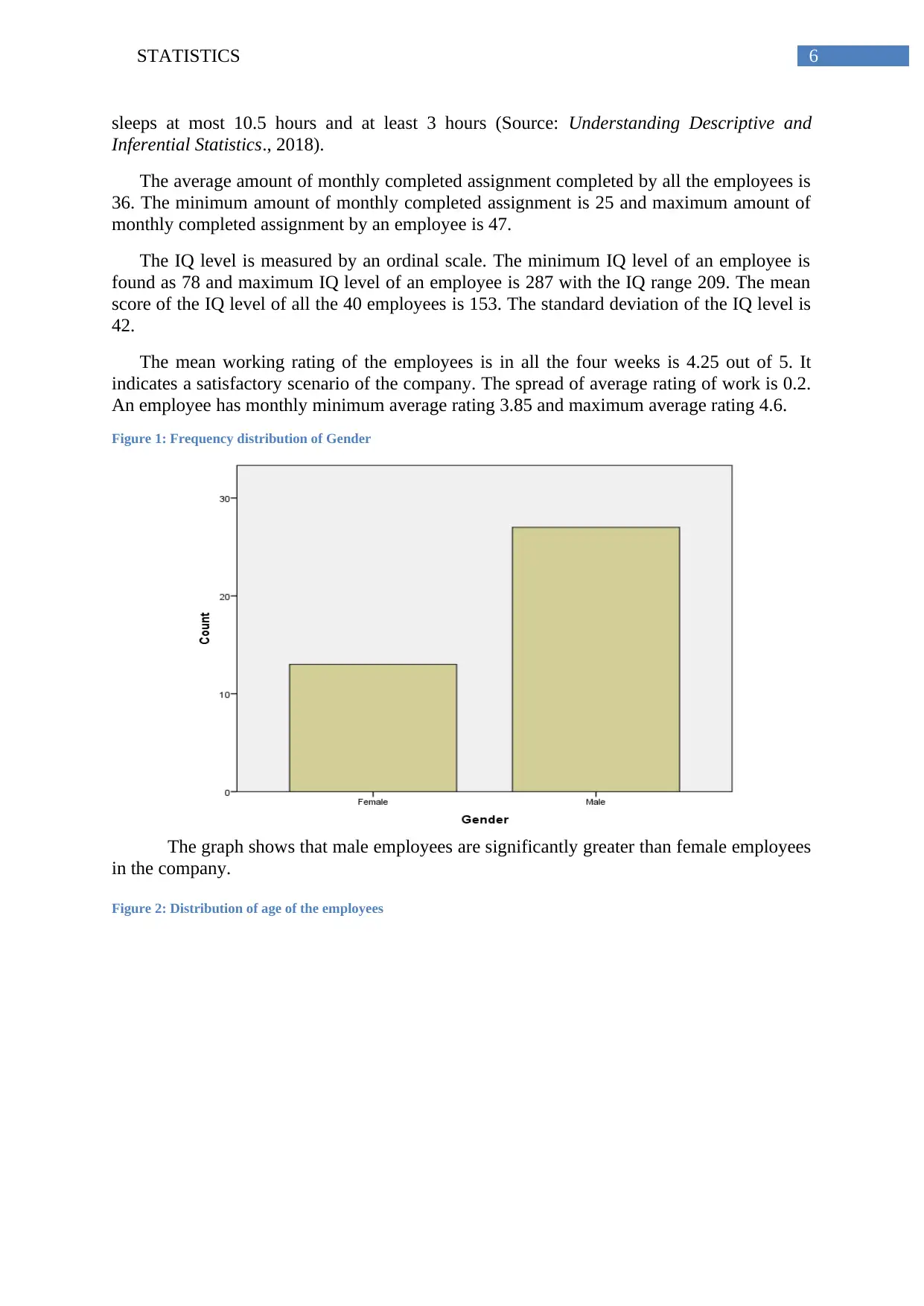
6STATISTICS
sleeps at most 10.5 hours and at least 3 hours (Source: Understanding Descriptive and
Inferential Statistics., 2018).
The average amount of monthly completed assignment completed by all the employees is
36. The minimum amount of monthly completed assignment is 25 and maximum amount of
monthly completed assignment by an employee is 47.
The IQ level is measured by an ordinal scale. The minimum IQ level of an employee is
found as 78 and maximum IQ level of an employee is 287 with the IQ range 209. The mean
score of the IQ level of all the 40 employees is 153. The standard deviation of the IQ level is
42.
The mean working rating of the employees is in all the four weeks is 4.25 out of 5. It
indicates a satisfactory scenario of the company. The spread of average rating of work is 0.2.
An employee has monthly minimum average rating 3.85 and maximum average rating 4.6.
Figure 1: Frequency distribution of Gender
The graph shows that male employees are significantly greater than female employees
in the company.
Figure 2: Distribution of age of the employees
sleeps at most 10.5 hours and at least 3 hours (Source: Understanding Descriptive and
Inferential Statistics., 2018).
The average amount of monthly completed assignment completed by all the employees is
36. The minimum amount of monthly completed assignment is 25 and maximum amount of
monthly completed assignment by an employee is 47.
The IQ level is measured by an ordinal scale. The minimum IQ level of an employee is
found as 78 and maximum IQ level of an employee is 287 with the IQ range 209. The mean
score of the IQ level of all the 40 employees is 153. The standard deviation of the IQ level is
42.
The mean working rating of the employees is in all the four weeks is 4.25 out of 5. It
indicates a satisfactory scenario of the company. The spread of average rating of work is 0.2.
An employee has monthly minimum average rating 3.85 and maximum average rating 4.6.
Figure 1: Frequency distribution of Gender
The graph shows that male employees are significantly greater than female employees
in the company.
Figure 2: Distribution of age of the employees
Paraphrase This Document
Need a fresh take? Get an instant paraphrase of this document with our AI Paraphraser
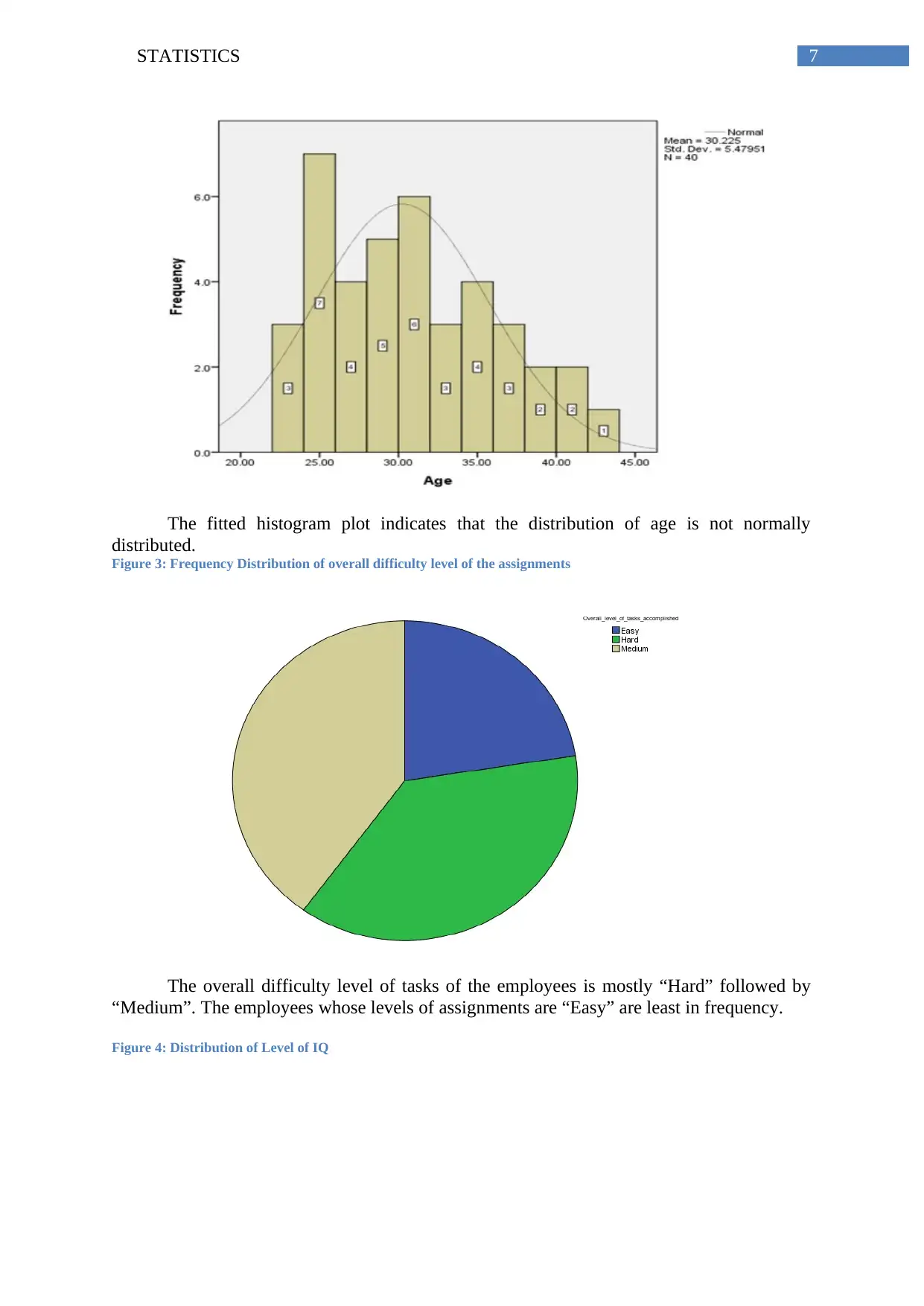
7STATISTICS
The fitted histogram plot indicates that the distribution of age is not normally
distributed.
Figure 3: Frequency Distribution of overall difficulty level of the assignments
The overall difficulty level of tasks of the employees is mostly “Hard” followed by
“Medium”. The employees whose levels of assignments are “Easy” are least in frequency.
Figure 4: Distribution of Level of IQ
The fitted histogram plot indicates that the distribution of age is not normally
distributed.
Figure 3: Frequency Distribution of overall difficulty level of the assignments
The overall difficulty level of tasks of the employees is mostly “Hard” followed by
“Medium”. The employees whose levels of assignments are “Easy” are least in frequency.
Figure 4: Distribution of Level of IQ
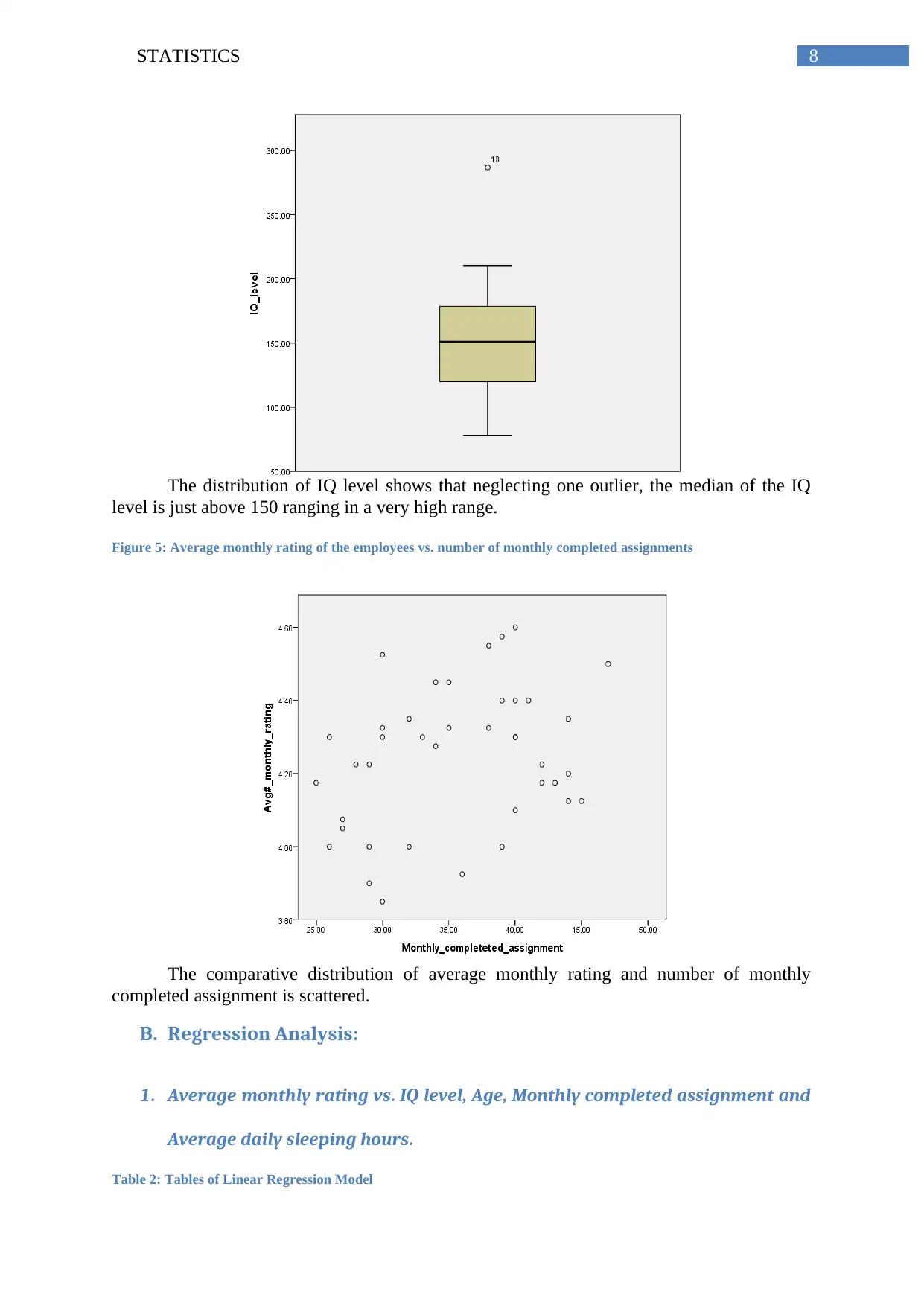
8STATISTICS
The distribution of IQ level shows that neglecting one outlier, the median of the IQ
level is just above 150 ranging in a very high range.
Figure 5: Average monthly rating of the employees vs. number of monthly completed assignments
The comparative distribution of average monthly rating and number of monthly
completed assignment is scattered.
B. Regression Analysis:
1. Average monthly rating vs. IQ level, Age, Monthly completed assignment and
Average daily sleeping hours.
Table 2: Tables of Linear Regression Model
The distribution of IQ level shows that neglecting one outlier, the median of the IQ
level is just above 150 ranging in a very high range.
Figure 5: Average monthly rating of the employees vs. number of monthly completed assignments
The comparative distribution of average monthly rating and number of monthly
completed assignment is scattered.
B. Regression Analysis:
1. Average monthly rating vs. IQ level, Age, Monthly completed assignment and
Average daily sleeping hours.
Table 2: Tables of Linear Regression Model
⊘ This is a preview!⊘
Do you want full access?
Subscribe today to unlock all pages.

Trusted by 1+ million students worldwide
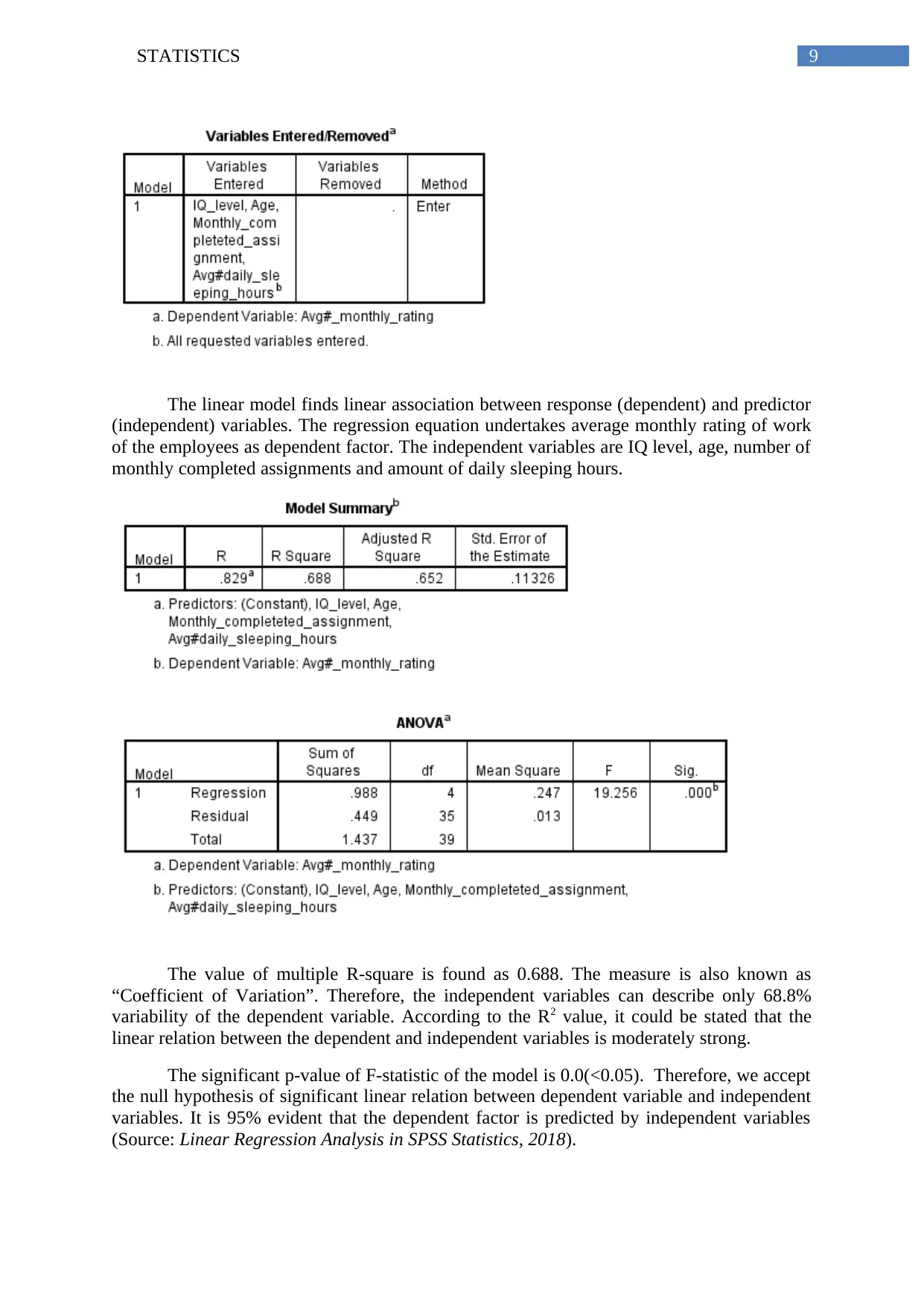
9STATISTICS
The linear model finds linear association between response (dependent) and predictor
(independent) variables. The regression equation undertakes average monthly rating of work
of the employees as dependent factor. The independent variables are IQ level, age, number of
monthly completed assignments and amount of daily sleeping hours.
The value of multiple R-square is found as 0.688. The measure is also known as
“Coefficient of Variation”. Therefore, the independent variables can describe only 68.8%
variability of the dependent variable. According to the R2 value, it could be stated that the
linear relation between the dependent and independent variables is moderately strong.
The significant p-value of F-statistic of the model is 0.0(<0.05). Therefore, we accept
the null hypothesis of significant linear relation between dependent variable and independent
variables. It is 95% evident that the dependent factor is predicted by independent variables
(Source: Linear Regression Analysis in SPSS Statistics, 2018).
The linear model finds linear association between response (dependent) and predictor
(independent) variables. The regression equation undertakes average monthly rating of work
of the employees as dependent factor. The independent variables are IQ level, age, number of
monthly completed assignments and amount of daily sleeping hours.
The value of multiple R-square is found as 0.688. The measure is also known as
“Coefficient of Variation”. Therefore, the independent variables can describe only 68.8%
variability of the dependent variable. According to the R2 value, it could be stated that the
linear relation between the dependent and independent variables is moderately strong.
The significant p-value of F-statistic of the model is 0.0(<0.05). Therefore, we accept
the null hypothesis of significant linear relation between dependent variable and independent
variables. It is 95% evident that the dependent factor is predicted by independent variables
(Source: Linear Regression Analysis in SPSS Statistics, 2018).
Paraphrase This Document
Need a fresh take? Get an instant paraphrase of this document with our AI Paraphraser
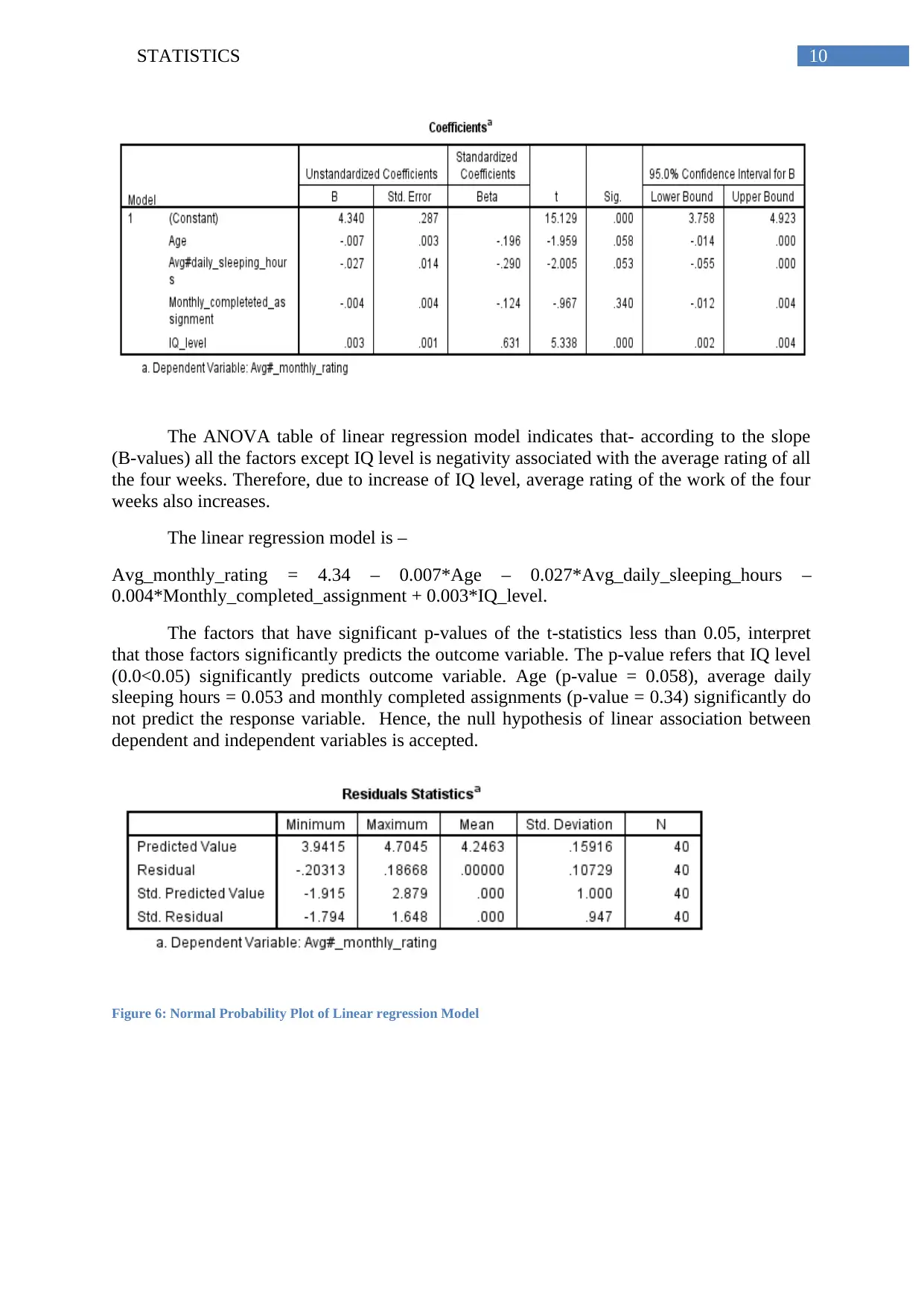
10STATISTICS
The ANOVA table of linear regression model indicates that- according to the slope
(B-values) all the factors except IQ level is negativity associated with the average rating of all
the four weeks. Therefore, due to increase of IQ level, average rating of the work of the four
weeks also increases.
The linear regression model is –
Avg_monthly_rating = 4.34 – 0.007*Age – 0.027*Avg_daily_sleeping_hours –
0.004*Monthly_completed_assignment + 0.003*IQ_level.
The factors that have significant p-values of the t-statistics less than 0.05, interpret
that those factors significantly predicts the outcome variable. The p-value refers that IQ level
(0.0<0.05) significantly predicts outcome variable. Age (p-value = 0.058), average daily
sleeping hours = 0.053 and monthly completed assignments (p-value = 0.34) significantly do
not predict the response variable. Hence, the null hypothesis of linear association between
dependent and independent variables is accepted.
Figure 6: Normal Probability Plot of Linear regression Model
The ANOVA table of linear regression model indicates that- according to the slope
(B-values) all the factors except IQ level is negativity associated with the average rating of all
the four weeks. Therefore, due to increase of IQ level, average rating of the work of the four
weeks also increases.
The linear regression model is –
Avg_monthly_rating = 4.34 – 0.007*Age – 0.027*Avg_daily_sleeping_hours –
0.004*Monthly_completed_assignment + 0.003*IQ_level.
The factors that have significant p-values of the t-statistics less than 0.05, interpret
that those factors significantly predicts the outcome variable. The p-value refers that IQ level
(0.0<0.05) significantly predicts outcome variable. Age (p-value = 0.058), average daily
sleeping hours = 0.053 and monthly completed assignments (p-value = 0.34) significantly do
not predict the response variable. Hence, the null hypothesis of linear association between
dependent and independent variables is accepted.
Figure 6: Normal Probability Plot of Linear regression Model
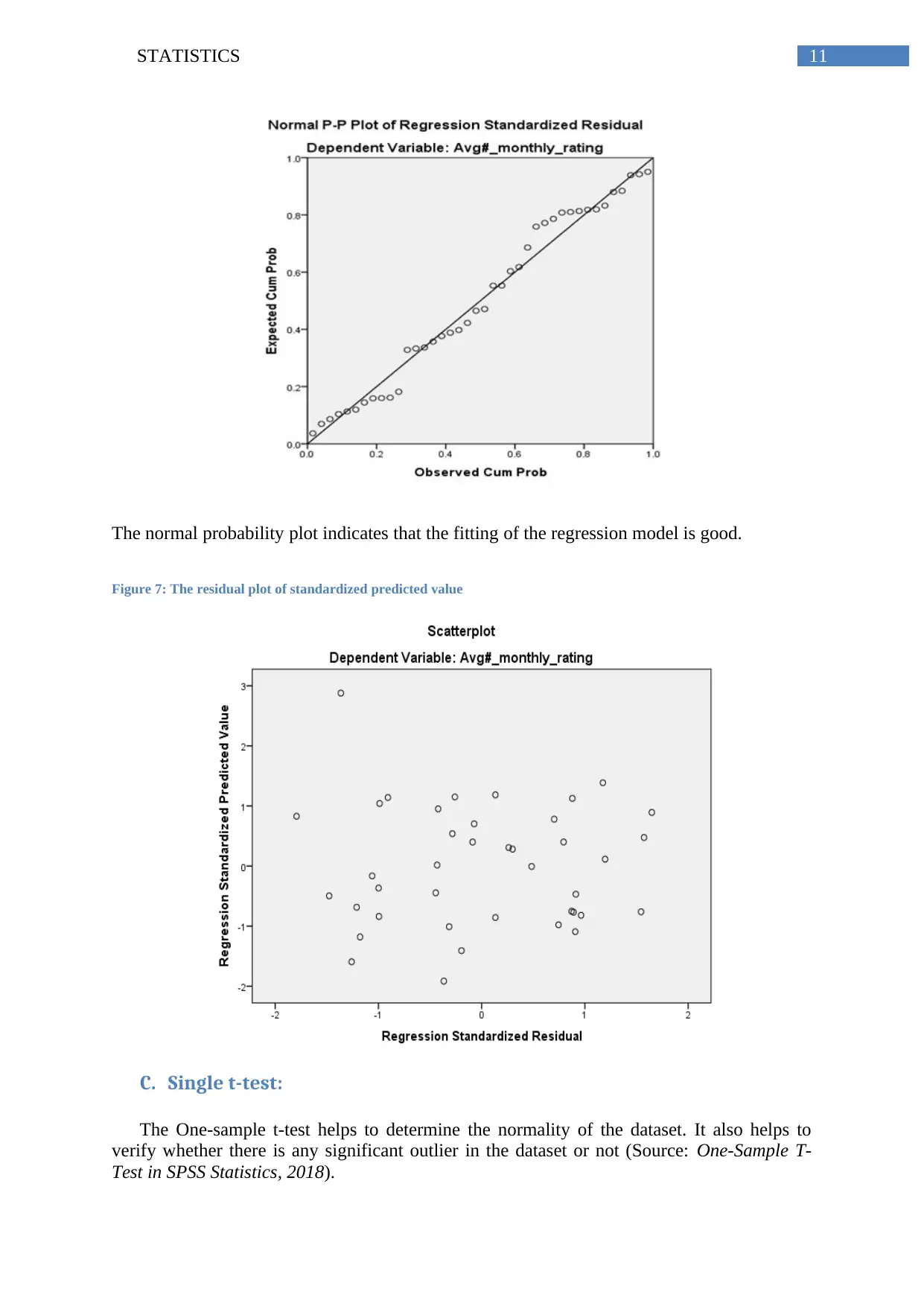
11STATISTICS
The normal probability plot indicates that the fitting of the regression model is good.
Figure 7: The residual plot of standardized predicted value
C. Single t-test:
The One-sample t-test helps to determine the normality of the dataset. It also helps to
verify whether there is any significant outlier in the dataset or not (Source: One-Sample T-
Test in SPSS Statistics, 2018).
The normal probability plot indicates that the fitting of the regression model is good.
Figure 7: The residual plot of standardized predicted value
C. Single t-test:
The One-sample t-test helps to determine the normality of the dataset. It also helps to
verify whether there is any significant outlier in the dataset or not (Source: One-Sample T-
Test in SPSS Statistics, 2018).
⊘ This is a preview!⊘
Do you want full access?
Subscribe today to unlock all pages.

Trusted by 1+ million students worldwide
1 out of 31
Related Documents
Your All-in-One AI-Powered Toolkit for Academic Success.
+13062052269
info@desklib.com
Available 24*7 on WhatsApp / Email
![[object Object]](/_next/static/media/star-bottom.7253800d.svg)
Unlock your academic potential
Copyright © 2020–2025 A2Z Services. All Rights Reserved. Developed and managed by ZUCOL.





